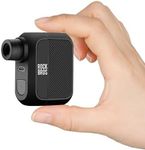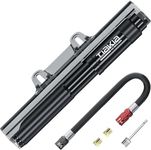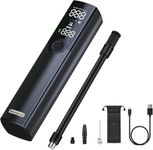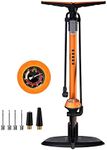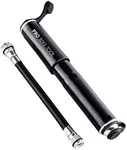Buying Guide for the Best Bike Pumps
Choosing the right bike pump can make maintaining your bicycle much easier and more efficient. The right pump will help you keep your tires at the correct pressure, which is essential for safety, comfort, and performance. When shopping for a bike pump, it's important to consider how and where you'll use it, the type of bike you have, and what features will make pumping easier for you. Understanding the key specifications will help you find a pump that fits your needs and makes inflating your tires a hassle-free task.Pump TypeThe type of pump refers to the overall design and intended use, such as floor pumps, mini pumps, or CO2 inflators. Floor pumps are larger and designed for home use, offering fast and easy inflation with less effort. Mini pumps are compact and portable, ideal for carrying on rides in case of emergencies, but they require more effort and time to inflate a tire. CO2 inflators are very small and use cartridges for quick inflation, making them great for quick fixes but not for regular maintenance. To choose the right type, think about whether you need a pump for home use, for carrying on rides, or for both.
Valve CompatibilityValve compatibility refers to the types of tire valves the pump can connect to, mainly Presta and Schrader valves. Presta valves are common on road bikes, while Schrader valves are found on most mountain and hybrid bikes. Some pumps work with only one type, while many have heads that fit both. It's important to know which valve your bike uses and ensure the pump matches, or choose a pump that can handle both types for maximum flexibility.
Maximum PressureMaximum pressure is the highest air pressure the pump can deliver, measured in PSI (pounds per square inch) or bar. Road bikes often require higher pressures (up to 120 PSI or more), while mountain bikes use lower pressures (30-50 PSI). Pumps with higher maximum pressure are more versatile, but if you only ride mountain bikes, you may not need a high-pressure pump. Choose a pump with a maximum pressure that matches or exceeds your bike's tire requirements.
Gauge TypeThe gauge type indicates whether the pump has a built-in pressure gauge and how it displays the pressure. Some pumps have no gauge, some have analog (dial) gauges, and others have digital displays. A gauge helps you inflate your tires to the correct pressure, which is important for performance and safety. If you want precise inflation, look for a pump with a clear, accurate gauge. If you just need a quick top-up, a gauge may be less important.
Size and PortabilitySize and portability refer to how big the pump is and how easy it is to carry or store. Floor pumps are larger and best kept at home, while mini pumps and CO2 inflators are small enough to fit in a bag or attach to your bike. If you need a pump for emergencies on the road, portability is key. For regular maintenance at home, a larger pump is more efficient and comfortable to use.
Build Quality and MaterialsBuild quality and materials affect how durable and reliable the pump is. Pumps can be made from plastic, metal, or a combination. Metal pumps are generally more durable and stable, while plastic pumps are lighter and often less expensive. If you plan to use your pump frequently or want it to last a long time, look for sturdy construction and quality materials.

